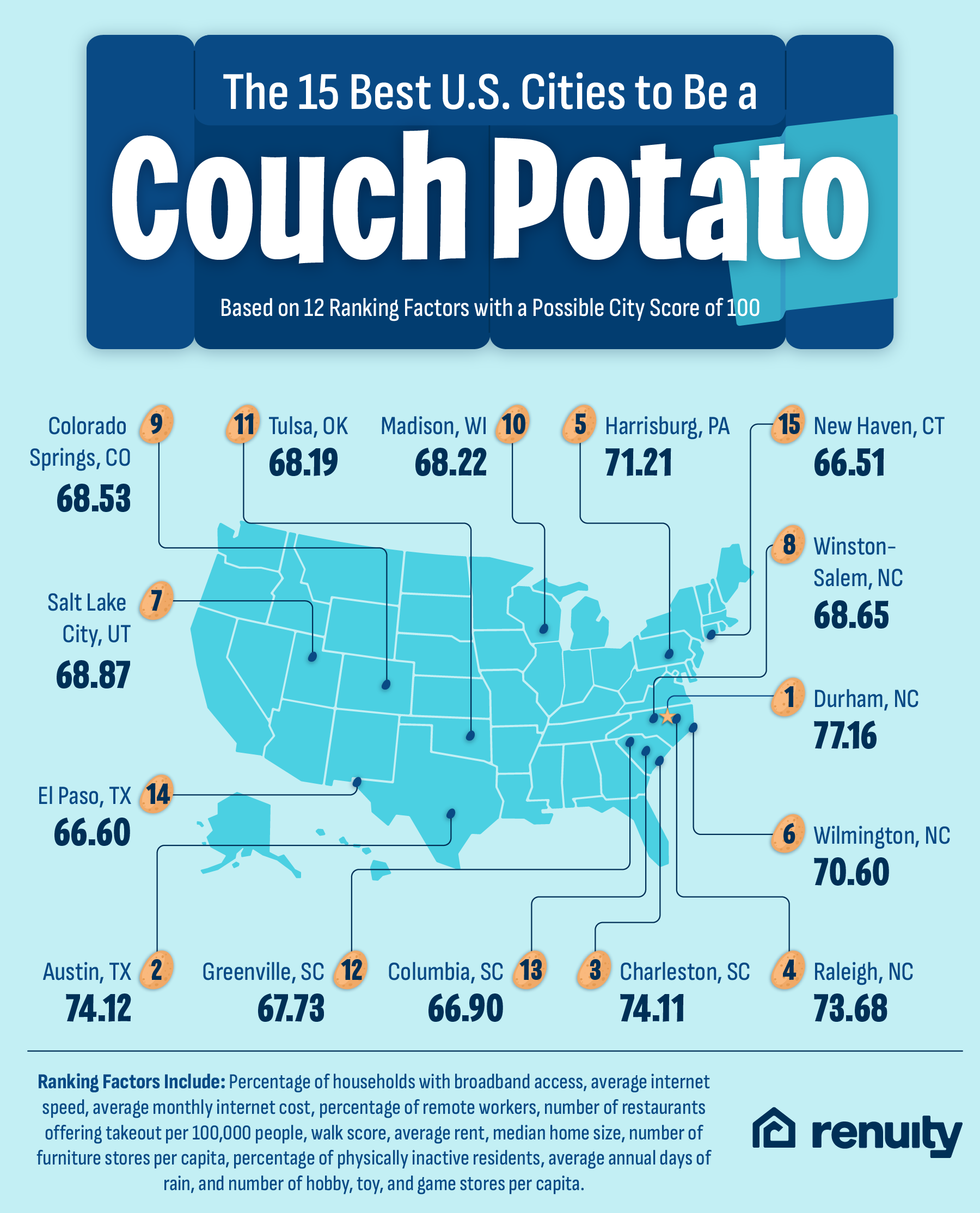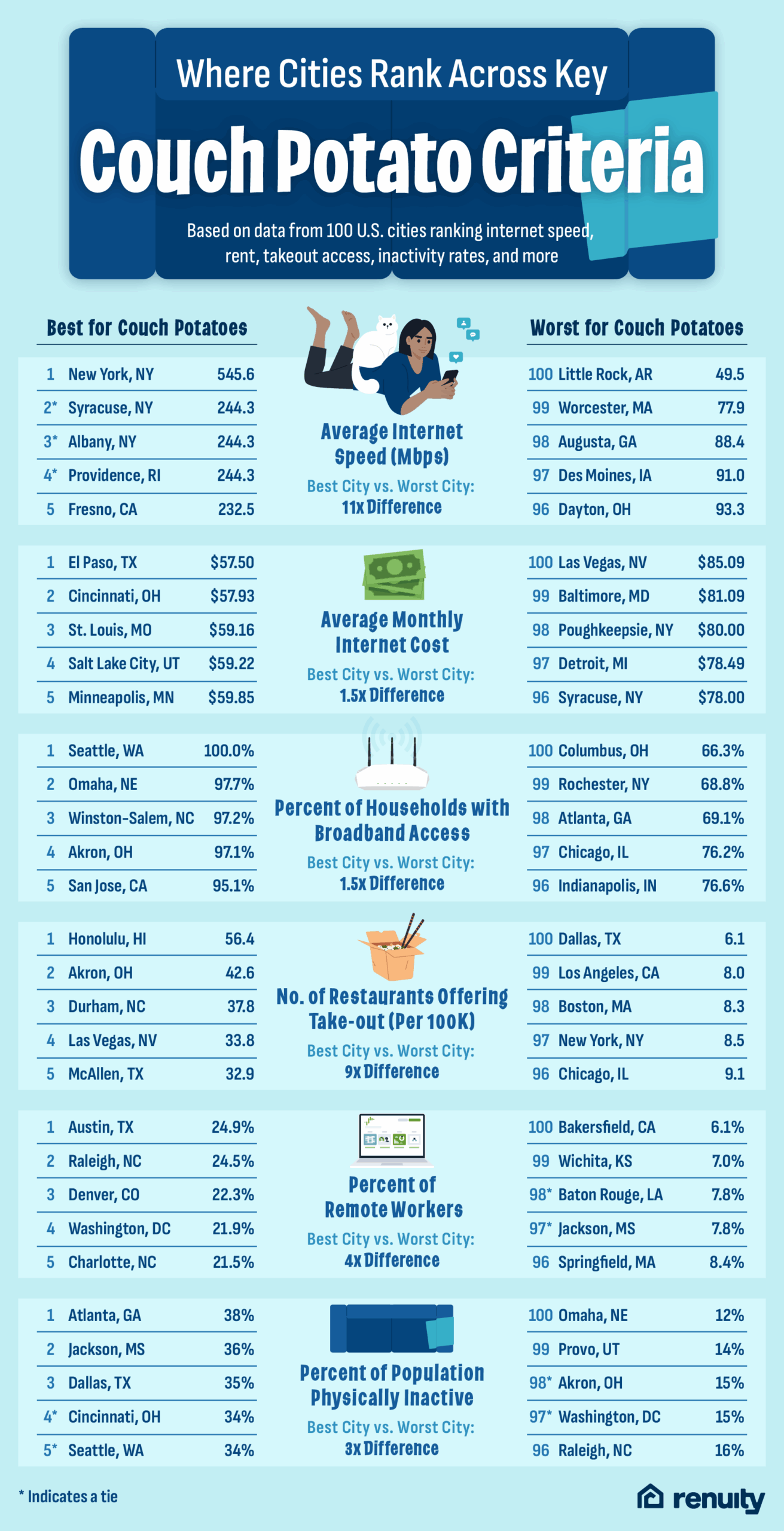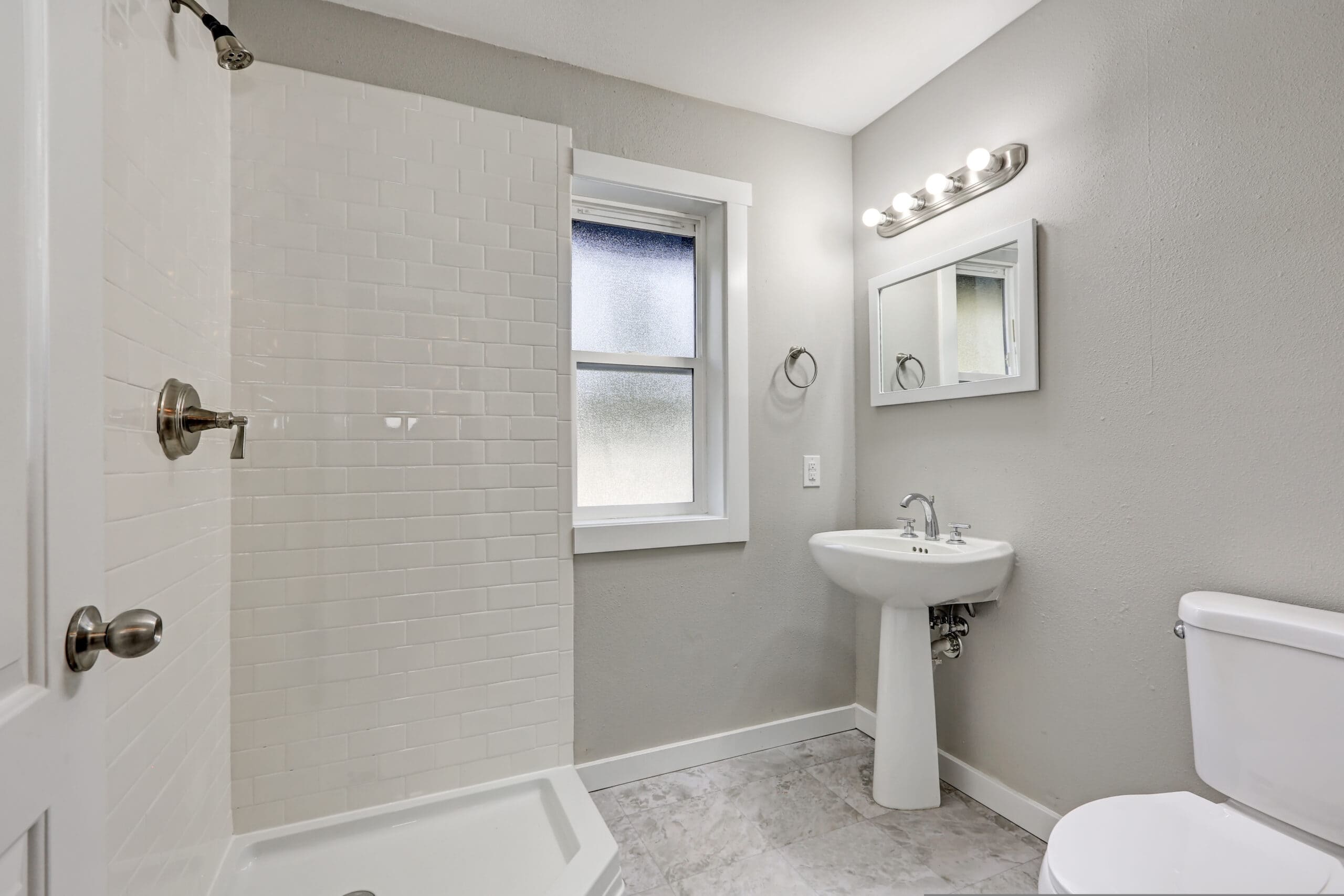In this lighthearted yet data-driven analysis, we’ve ranked the 100 most populous U.S. cities based on their “couch-friendliness.” We considered factors such as broadband availability, food and grocery delivery options, remote job opportunities, and weather conditions that encourage staying indoors. Whether you’re a homebody by choice or circumstance, this ranking will reveal the ultimate cities for cozy, at-home living.
Key Findings
- North Carolina is a couch potato hotspot, with four cities—Durham, Raleigh, Wilmington, and Winston-Salem—landing in the top 10 thanks to strong internet, affordable housing, and abundant takeout options.
- New York, Syracuse, and Albany, NY top the list for fastest internet speeds, ensuring buffer-free bingeing and smooth remote work.
- Durham, NC and Akron, OH have the most takeout-friendly restaurants per capita, making it easier than ever to dine without leaving the couch.
- Austin, TX, Raleigh, NC, and Denver, CO lead the nation in remote work rates, reinforcing their status as ideal cities for homebodies.
- El Paso, TX offers the lowest monthly internet costs, making high-speed access more affordable for stay-at-home streamers.
What Turns an Ordinary City into a Couch Potato’s Paradise?
What does it take to make a city perfect for embracing a life of leisure? We measured how well a city removes the three biggest reasons to go outside—spotty internet, great weather, and empty cupboards—and how effectively they turn staying in into a pleasure, not a compromise.
Fast, affordable internet is the first step. Cities with high broadband coverage, fast average speeds, and reasonable monthly costs make it easy to stream, game, or work without lag or bill shock. We also looked at the number of takeout-friendly restaurants per capita, because when your fridge is empty, food that comes to you is a lifeline. A high share of remote workers suggests that local infrastructure and culture already support a stay-at-home lifestyle.
Comfort is key, too. Cities with larger, more affordable homes offer space for a sectional sofa and a giant TV—essentials for any dedicated homebody. A high number of furniture stores per capita makes it easy to level up your living room. We also looked at a city’s walk score; fewer walkable amenities mean fewer temptations to leave the house.
Weather also plays a role; cities with frequent rainy days offer a built-in excuse to stay cozy indoors. A higher percentage of physically inactive adults suggests a culture that embraces relaxation. And more hobby, toy, and game stores per capita means easy access to puzzles, board games, and video game fuel for an ideal weekend of lounging.
Put it all together, and these metrics reveal the cities where high-speed Wi-Fi, endless takeout, cozy homes, and dreary weather combine to create the ultimate couch potato paradise.
Ranked: The Top 15 Cities for Couch Potatoes

When it comes to seamless streaming, endless take-out options, and homes built for cozy contentment, these 15 cities stand out from the crowd. Each earned top marks across key criteria, including broadband coverage, remote work readiness, home size, and furniture access. Whether it’s the rainy-day weather in Wilmington, NC, the high share of remote workers in Austin, TX, or the abundance of takeout-friendly restaurants in Durham, NC, these metro areas create the perfect backdrop for a homebody lifestyle.
The top performers also share common threads: affordable housing, fast internet, and a built environment that subtly discourages constant outings. Salt Lake City, UT, and Colorado Springs, CO, for instance, blend spacious living with moderate climates that are ideal for indoor hobbies. North Carolina cities dominate the list, claiming four of the top 10 spots. Raleigh, Winston-Salem, and Wilmington complement Durham’s strong showing, cementing the state’s reputation as a haven for those who thrive indoors.
Breaking Down the Best (and Worst) Cities for the Couch Potato Life

While our overall ranking highlights the top cities for full-time lounging, we also wanted to zoom in on specific couch-potato criteria to see which cities shine, or struggle, in key categories. From internet speed and takeout access to remote work culture and physical activity levels, these city-level callouts reveal how different places stack up when it comes to enabling a life of maximum comfort and minimal effort.
Which Cities Have the Fastest (and Slowest) Internet?
Fastest Internet Speeds
- New York, NY
- Syracuse, NY
- Albany, NY
New York State cities dominate in internet speed, driven by dense infrastructure and competitive broadband markets. Even smaller metros like Syracuse and Albany benefit from regional investment in fiber networks.
Slowest Internet Speeds
- Little Rock, AR
- Worcester, MA
- Augusta, GA
These cities struggle with slower speeds, likely due to aging infrastructure or limited provider options. Gaps in digital investment may be holding them back from more reliable at-home connectivity.
Where Are Internet Bills the Cheapest — and the Priciest?
Lowest Monthly Internet Costs
- El Paso, TX
- Cincinnati, OH
- St. Louis, MO
These cities offer the most affordable internet service, helped by lower living costs and stronger provider competition. For budget-conscious homebodies, this keeps streaming and remote work within reach.
Highest Monthly Internet Costs
- Las Vegas, NV
- Baltimore, MD
- Poughkeepsie, NY
Higher internet costs in these metros could stem from limited provider choice or higher baseline service tiers. In some cases, residents may be paying a premium for basic connectivity.
Which Cities Have the Most (and Least) Widespread Internet Access?
Most Households with Broadband Access
- Seattle, WA
- Omaha, NE
- Winston-Salem, NC
These cities boast high broadband coverage, suggesting strong infrastructure and high digital adoption. Even smaller metros like Winston-Salem show what’s possible with targeted investment.
Fewest Households with Broadband Access
- Columbus, OH
- Rochester, NY
- Atlanta, GA
Despite their size, these cities have lower broadband access—often tied to income disparities or under-resourced neighborhoods. The digital divide remains a challenge even in urban areas.
Where Can You Order Takeout the Most Easily?
Most Takeout Restaurants Per 100K Residents
- Honolulu, HI
- Akron, OH
- Durham, NC
A strong takeout culture defines these cities, where residents have easy access to food delivery options. In places like Durham, a growing restaurant scene helps reinforce its stay-at-home appeal.
Fewest Takeout Restaurants Per 100K Residents
- Dallas, TX
- Los Angeles, CA
- Boston, MA
Large populations don’t always mean better takeout access. Factors like traffic, zoning restrictions, and urban sprawl may limit restaurant density in these metros.
Which Cities Have the Highest (and Lowest) Work-from-Home Rates?
Highest Percent of Remote Workers
- Austin, TX
- Raleigh, NC
- Denver, CO
Tech-forward cities like Austin and Raleigh continue to lead the remote work movement. A high share of WFH residents reflects a lifestyle that’s already centered around staying home.
Lowest Percent of Remote Workers
- Bakersfield, CA
- Wichita, KS
- Baton Rouge, LA
These metros are tied to industries that require in-person work, like agriculture, energy, and manufacturing. Remote-friendly infrastructure may be less developed in these regions.
Where Are People the Least (and Most) Physically Active?
Most Physically Inactive Populations
- Atlanta, GA
- Jackson, MS
- Dallas, TX
High inactivity rates in these cities point to cultural and environmental factors—like car reliance or limited walkability—that support more sedentary routines. For couch potatoes, that means fewer reasons to venture out.
Least Physically Inactive Populations
- Omaha, NE
- Provo, UT
- Akron, OH
Residents in these cities are more active overall, possibly due to younger demographics or more outdoor-oriented lifestyles. Still, these metros manage to balance activity with convenience and comfort.
Closing Thoughts
Whether you’re working from home, binge-watching your favorite shows, or simply spending more time indoors, your space plays a big role in your comfort. Renuity offers home upgrades that support this lifestyle—from custom closets that reduce clutter to home storage and garage storage systems that make everyday living more functional. In the cities where staying in is the norm, these upgrades can help make your home even more enjoyable.
Methodology
We ranked the 100 largest U.S. metros on 12 data points tied to streaming quality, food convenience, and indoor comfort. Each metric was scaled from 0 to 5, multiplied by the weight below, and summed for a 0–100 Couch-Potato Score (higher = easier life on the sofa).
Percent of Households with Broadband Access
- Weight: 2
- Source: County Health Rankings
- Why? Broadband ubiquity shows how many residents can actually enjoy high-bandwidth entertainment at home.
Average Internet Speed
- Weight: 3
- Source: BroadbandNow
- Why? Faster downloads eliminate buffering for HD and 4K streaming.
Average Monthly Internet Cost
- Weight: 2
- Source: Numbeo
- Why? Affordable plans keep fast service within reach; high prices force trade-offs.
Percent of Remote Workers
- Weight: 2
- Source: U.S. Census ACS (2023 DP03)
- Why? A large WFH share signals infrastructure and lifestyle norms already centered on staying home.
Restaurants Offering Take-out per Capita
- Weight: 3
- Source: YellowPages
- Why? A deeper delivery scene removes one of the last reasons to leave the couch.
Walk Score
- Weight: 1
- Source: WalkScore.com
- Why? Fewer amenities within walking distance discourages outings and nudges residents to stay in.
Average Rent
- Weight: 2
- Source: Rent.com
- Why? Cheaper housing frees up cash for streaming services, take-out, and comfy furniture.
Median Home Size
- Weight: 1
- Source: Movoto market-trends pages
- Why? Roomier living spaces accommodate sectionals, big-screen TVs, and gaming setups.
Furniture Stores per Capita
- Weight: 1
- Source: U.S. Census NAICS 442110
- Why? Easy access to couches and recliners makes upgrading your nest painless.
Percent of Adults Physically Inactive
- Weight: 1
- Source: County Health Rankings
- Why? High inactivity suggests a social norm that doesn’t shame sedentary routines.
Annual Days of Rain
- Weight: 1
- Source: WeatherSpark climate normals
- Why? Frequent wet weather provides a built-in excuse to stay indoors and binge.
Hobby, Toy & Game Stores per Capita
- Weight: 1
- Source: U.S. Census business counts
- Why? More brick-and-mortar options for video games and toys fuel long nights.








